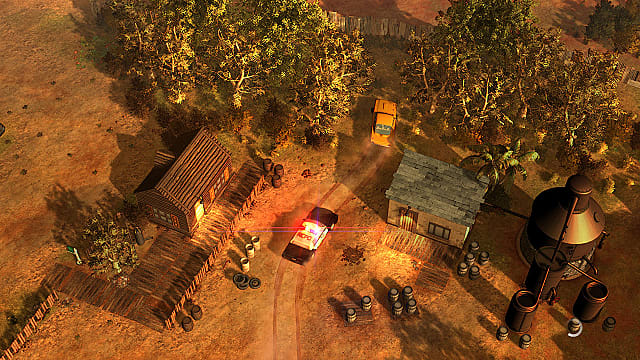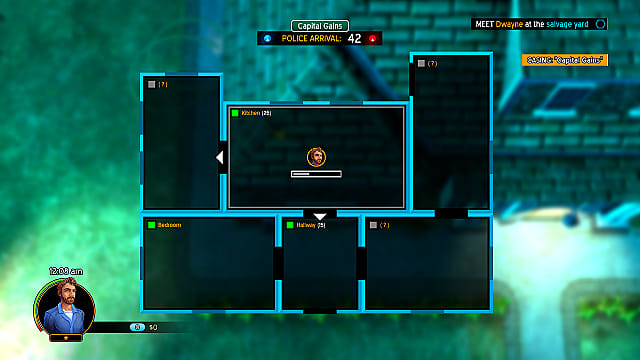

Do you yearn for the days of the Grand Theft Auto of yesteryear? Before Rockstar changed the crime sim forever with Grand Theft Auto 3, that little series of open world driving and shooting looked considerably different. If you find yourself looking back with fond memories at those top down mayhem simulators, American Fugitive may be just the thing to scratch that itch.
American Fugitive is a direct homage to those GTA games of the past, upgrading the graphics and destructibility of the environments, but maintaining many of the gameplay elements (for better and for worse) of that particular genre. It can't be recommended for everyone, but it has a certain charm that makes it worth a go for many.
Criminals Gonna Criminal

When you start up American Fugitive, a brief prologue introduces your main character (Will) and some of the basic gameplay mechanics. Story is told through dialogue options, but don't expect anything too fancy in that realm. A logical story is not one of American Fugitive's strong points.
Will is called to his father' house and, when he arrives, he discovers that his dear old dad has been murdered. Worse yet, the police arrive and throw Will in jail for the crime. After breaking out (it all happens very quickly), Will goes on a quest to prove that he is innocent of all charges.
He does this by breaking into houses, robbing stores, stealing cars, and murdering police officers.
Honestly, this turn of events was a jarring one. Will insists he is not a criminal, yet he gleefully pulls women out of their cars and drives off, ramming police into trees all the while. Even the game's description from the developers page reads: "Set in a sleepy American country town in the 1980s, American Fugitive invites you to play as Will Riley. You're no angel, but you're not a killer."
Except you totally are.
Luckily, American Fugitive has some strong gameplay elements to make up for its... questionable story beats.
Buckle Up

The best element of American Fugitive is the driving. The game takes place in a country town, so there is plenty of room to get up to speed and pull some fun driving tricks. There is a pretty good variety of vehicles available for you to commandeer, and each feels very different in terms of speed, acceleration, and weight.
When you're driving a tow truck around, you feel powerful. As your wanted level increases and the police pull out ever more tricks to stop you, a big heavy truck will make you feel like you can drive right through them. However, a quick little muscle car will test your reflexes as you drive circles around town, trying to evade arrest.
Not everything about the driving is perfect -- the cops' interest in you seems very hit and miss on occasion. For example, swerving into a police car while towing an ATM behind you may barely get their attention, but you better not run over a lightpole where any officers can see you.
Damage calculation is a bit haphazard and cars explode a bit too quickly once they reach critical mass. Overall, the driving is very satisfying and ticks a lot of the boxes you want in a game like this.
Keep an Eye on the Timer

It isn't all kicking tires in American Fugitive: there are a few other central gameplay elements on display in the game. One of the most interesting - and probably most divisive - is the way you break into and loot buildings. Before entering, you can peek in windows and see if anyone is home. If you have found the keys, you can let yourself in and take all the time you need to collect valuables. Otherwise, you'll need to break a window, and that's when the timer starts counting down.
Entering a building will pull up a blueprint-like view of the building you're in, with an ever present timer ticking down until the cops arrive. Each room will run a set amount of time off the clock, forcing you to prioritize and make some quick decisions to get as much loot as you can carry and get out before the police show up.
The system adds a good deal of intensity to your thievery, replacing what would probably be pretty boring if it stayed the same view and mechanics as the central gameplay. This tiny little twist encourages you to explore and take your time with certain elements of your crime spree - and keeps American Fugitive from being too much of the same throughout its runtime.
Building A Better Speed Trap

Not every element of American Fugitive works as well as the driving and burglary sections, however. The shooting feels loose and imprecise: an early quest sees you in a showdown with several police officers, and seems to encourage you to take some cover. A much more effective plan than ducking behind a building and taking potshots is to run out in the middle of six officers, blasting each from close range and absorbing the shots they fire at you.
In classic video game fashion, just drink a coffee and eat a granola bar afterwards. Your health will be right back where it started, despite the multiple bullet wounds you sustained.
There's something about the controls when you're outside of a vehicle that just doesn't quite work. Will feels sluggish: his running animation is slow and his sprint meter runs out far too quickly. Shooting feels imprecise, so it's a good thing you get outfitted with a machine gun quickly - single shot rifles and pistols lead to frustration here.
Luckily, there are ways to increase your character's stats to help shore up some of those problem areas. However, it doesn't always work quite as planned.
Eat Your Vitamins

There are also some light RPG elements included in American Fugitive. As you complete certain missions and objectives, you earn skill points that can increase your abilities in various areas. You can pump extra points into your foot speed, the damage you or your vehicles take, and how quickly your health regenerates. As you put more points into certain areas, they will start to cost more and more to increase.
The unfortunate side of this progression system is how little it all seems to matter. It surely does -- your car taking 10% less damage will get you out of more scrapes than it won't. However, nearly every skill you earn is a passive increase to a RNG, meaning the impact of these skills is rarely seen or felt.
American Fugitive isn't the type of game that should have massive amounts of abilities to trigger, but it would be nice if you could actually see the difference in how much damage you're doing or taking, rather than just blindly putting points into skills and hoping that it works out like you want.
On the Lam

Pros:
- Driving mechanics are well done
- Burglary sections are an interesting break in gameplay
- Big, open world with lots to do
- Destructible environment looks great
Cons:
- Story makes zero sense
- Shooting feels imprecise
- Skill tree doesn't feel impactful
There is a lot to do in American Fugitive, and a lot of it works well. It hits that sweet spot where everything holds up whether you're out on missions or just driving around and exploring. You can definitely feel the game's limitations, but that doesn't feel like a problem -- many of them add to the charm that American Fugitive brings to the table.
You'll get your money's worth out of this one, and you'll have a good time doing it. Just make sure to cue up the Dukes of Hazzard theme song, you'll want it on hand for certain sections.
[Note: A copy of American Fugitive was provided by Curve Digital for the purpose of this review.]
0 comments:
Post a Comment